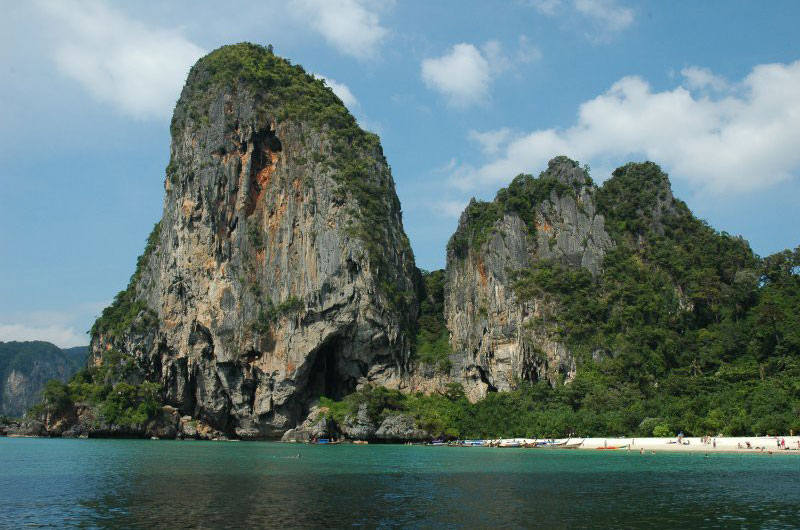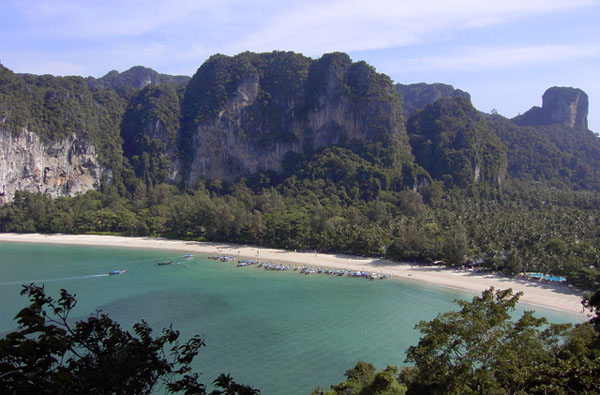Fine Sand Beaches and Mountains on Rai Leh, Thailand
Rai Leh also commonly known as Railay is a small peninsula just south of the town of Ao Nang, Krabi. It’s attached to Krabi’s mainland, but cut off by towering limestone cliffs from all the roads and towns. This isolation from the mainland, and the complete absence of cars and roads, gives Railay Beach a very island feel. While the powdery white sand beaches attract boat loads of travellers, Rai Leh is primarily known as a rock climbing hot spot, attracting climbers from all over the world to its superb towering limestone.
Rai Leh is considered to be all of the peninsula, which has four primary areas:
Phra Nang: a fine white sand beach, on the southern tip of the peninsula
Rai Leh East: the mangrove side of the peninsula, used by long-tails to/from Krabi
Rai Leh West: a fine beach of white sand and shallow water, where most long-tails arrive from Ao Nang
Ton Sai: a cove around the corner from Rai Ley West where rockclimbers and backpackers hang out in cheap accomodation and practice climbing
It’s a 5-10 minute walk between any of these landmarks. The village itself is a pedestrian’s dream, as there are no cars, and the uneven bumpy walkways make even bicycles impractical.

The mighty Thaiwand Wall with Phra Nang Beach on the right. Photo by jpatokal
On the east side of the peninsula, to the north of Rai Leh East, Diamond Cave is an interesting place to explore and one of the few strictly sight-seeing destinations at Rai Leh. A nominal entrance fee pays for a short walk along the lit boardwalk through formations that glitter as if they were full of diamonds. Though not breathtakingly large (and thus easily viewed in about fifteen minutes) it is quite beautiful.
Phra Nang Shrine, north end of Phra Nang Beach. Dedicated to the spirit of the drowned princess (phra nang) who gave the beach her name, this small shrine in a small cave is notable primarily for the dozens of carved red-tipped phalluses donated by fishermen seeking her favour.
Rai Leh is perhaps the best winter sport rock climbing area in the world, with over a thousand bolted routes up limestone faces with breathtaking views over the ocean. If you are an avid rock climber, chances are you already know about this place and the spectacular cliffs are the reason you are here.
Climbing is graded on the French scale, most is steep and challenging with only limited possibilities for beginners. Due to the corrosive nature of the seaside location, the bolts may be of questionable integrity, bolt failure is not uncommon here, and threads (rope tied through holes in the rock) may be of questionable integrity as well. Overall the rock quality is superb; however, like everywhere else, you will find the occasional loose section including the famed Rai Leh stalactites.
Required climbing gear: Rai Leh and around is all sport climbing. Beyond a 60 metre (200 foot) rope, sixteen quickdraws, your harness, shoes and a lot of chalk, you won’t need much else. Anything you forget or don’t have can be rented at the climbing shops.
Rai Leh and Tonsai have several guide operators with services ranging from introductory rock climbing courses to rent-a-belay partner.
Rai Leh is not a major diving spot as the local coral and sea life is not as diverse or spectacular as other areas of Thailand. However there is a dive shop that will certify divers and take them on boat trips to decent dive sites, including a sunken wreck. Serious divers tend to prefer the Similan Islands, Ko Phi Phi or Ko Lanta for quality diving.
King Cruiser is a car ferry that sank in 1997, providing the area with its only wreck, located at 30 meters. Unfortunately its condition is deteriorating fairly fast in the warm waters. This is the most popular dive site in the area.

Rai Leh Beach (West), taken from Thaiwand Wall. Photo by Johnycanal
Snorkeling is not a major draw for Rai Leh though it is possible to swim out and see coral and fish a few meters off the sandy beaches. Beware of the ever present longtail boat traffic.
Most looking for some snorkeling fun rent a longtail and head for the islands south and west of Rai Leh, such as Poda Island, but even there the snorkelling is only moderate. Some hotels organize snorkeling trips or you may prefer to charter your own boat for the afternoon. A one way trip usually takes less than 25 minutes.
While not as good as at Phang Nga, the kayaking around the peninsula at Rai Leh affords a great alternative to climbing and a stunning view of the area. Several of the limestone islets off Phra Nang beach have sea caves eroded into their bases, including a few large enough to offer opportunities to beach the kayaks and explore. Paddling into caves and through subterranean passages is particularly interesting, but watch out for low, jagged ceilings. For those with more ambition, a short open-water crossing (about one hour of steady, heavy paddling) leads to the private island of Ko Poda which has beautiful and relatively isolated beaches.
Several bungalow resorts on the Rai Leh West side of the peninsula have sea kayaks available for rental for around 600 baht/half-day, 1000 baht/full-day (including life-vests). The kayaks are simple two-seat plastic models, but perform fine on the millpond-smooth water of the bay. A half-day is probably plenty long enough to explore the immediate environs of Rai Leh. A bottle of water, a hat and plenty of sun protection are essential!
Rai Leh itself does not offer many trekking opportunities, as the peninsula is so tiny. The one interesting and undeveloped area is the jungle atop the limestone towers that make up the club-shaped southern end of the peninsula. Along the paved path that runs from Rai Leh East to Phra Nang beach, a so-called “trail” leads up a slippery, rocky embankment to the jungle-covered plateau. A narrow, indistinct trail cirles the top of the southern tower, with a left turn offering access to the highest point (accessible via a sheer face and thus navigable only with climbing gear) as well as a fantastic lookout point over the peninsula. A right turn on the path leads downward into a hidden glen, which provides access to the secret lagoon called Sa Phra Nang or Holy Princess Pool. The route from this glen to the lagoon leads down a steep, rocky ravine, and the path is covered with slippery red clay, making it quite treacherous even for the experienced. The technique is not so much climbing as scrambling, and the knotted nylon ropes are often more dangerous than they are helpful. The lagoon itself is breathtakingly beautiful, but try not to step in, as the soft bottomless muck has quite a penchant for trekkers’ footwear.

Railay Beach inland. Photo by Diggnet
As Rai Leh is a peninsula surrounded by ocean and mountains, final access can only be by boat. Long-tails depart from Ao Nang (10 minutes, 60 baht/person) and Krabi (30 minutes) on demand, making those towns the gateways to Rai Leh. It’s also possible to access Rai Leh via regular ferries that run between Ko Lanta, Ko Phi Phi, and Phuket (more frequent in the November-May dry season.
From Bangkok there are flights to Krabi and Phuket, direct bus services, and trains to Surat Thani with onward connections by bus.
Most exit Rai Leh as they came in. The Phi Phi Islands, Ko Lanta and Phuket are easy destinations from Rai Leh and transportation can be easily booked through any hotel or activity center.







